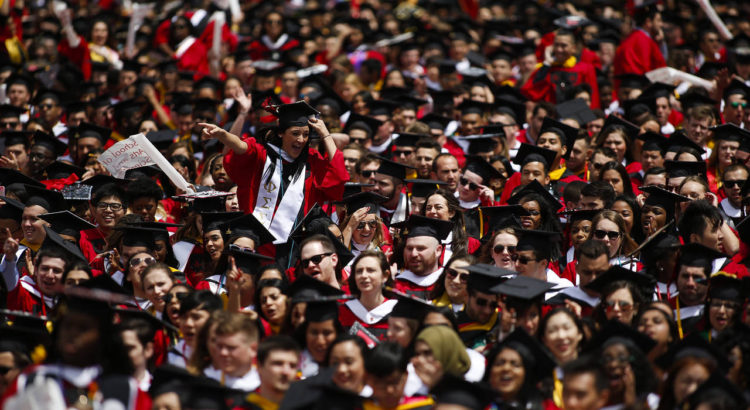EE.UU/22 de julio de 2016/blogs.wsj.com/By Josh Mitchell
Resumen:
La Casa Blanca acaba de lanzar un gran informe sobre la deuda que adquieren los estudiantes de universidades, las cuales contienen todos los horrores familiares sobre las escuelas con fines de lucro, abandonos endeudados y estudiantes morosos en sus préstamos. Pero tiene una conclusión interesante: Esa pila creciente de US $ 1,3 billones en deuda del estudiante está ayudando a no lastimar, la economía de Estados Unidos.
Esta conclusión deviene de muchos defensores de los estudiantes y grupos de intereses especiales, de los agentes de bienes raíces y los empleadores que buscan nuevos recortes de impuestos para sus trabajadores jóvenes-que sostienen que la deuda del estudiante es un gran «arrastre» en la economía. ( Hillary Clinton y Donald Trump han criticado cada uno el aumento de la deuda del estudiante.) Sin embargo, el informe de 77 páginas de los Asesores Económicos del Consejo de la Casa Blanca demuestra con numerosos gráficos y estudios de economistas y académicos, que la deuda de los estudiantes representa un problema para las familias.
El aumento de la deuda de los estudiantes se produjo en gran medida con el presidente Barack Obama, a pesar de que comenzó varios años antes. Desde principios de 2009, cuando el Sr. Obama asumió el cargo, la deuda del estudiante casi se ha duplicado, cerca de $ 1.3 billones en la actualidad, de acuerdo con la Reserva Federal de Nueva York. El repunte es debido en gran medida al lamentable estado de la economía: Durante el alto desempleo, la inscripción en la universidad y la escuela de posgrado suele aumentar. Esto se debe a los trabajadores, el llamado coste de oportunidad de ir a la escuela a los salarios que perder que no se trabaje, es menor.
Su conclusión: «El principal impacto macroeconómico de los préstamos estudiantiles, sobre todo en el largo plazo, es a través del impulso a la producción y la productividad para formar una fuerza de trabajo más educada».
Noticia original:
The debt surge has hurt many, but adds to overall economic output and productivity, report says
A new report from the White House suggests education, not student debt, drives the differences in homeownership among borrowers. Here, graduates of Rutgers University at their commencement ceremony in May. ENLARGE
A new report from the White House suggests education, not student debt, drives the differences in homeownership among borrowers. Here, graduates of Rutgers University at their commencement ceremony in May.
The White House just released a big report on student debt that contains all the familiar horrors about for-profit schools, indebted dropouts and students defaulting on their loans. But it has an interesting conclusion: That growing stack of $1.3 trillion in student debt is helping, not hurting, the U.S. economy.
That conclusion is sure to rankle the many student advocates and special-interest groups—from real-estate agents to employers seeking new tax breaks for their young workers—that argue student debt is a big “drag” on the economy. (Hillary Clinton and Donald Trump have each decried the rise in student debt.) But the 77-page report from the White House Council of Economic Advisers backs up its claim with numerous charts and studies from economists and academics.
The surge in student debt occurred largely on President Barack Obama’s watch, though it began several years earlier. Since early 2009, when Mr. Obama took office, student debt has nearly doubled, to about $1.3 trillion today, according to the New York Federal Reserve. The uptick owed much to the sorry state of the economy: During high unemployment, enrollment in college and graduate school typically rises, the White House notes. That’s because for workers, the so-called opportunity cost of going to school–the wages they lose from not working—is lower.
MORE IN STUDENT DEBT
Government on Track to Forgive Up to $131,000 Each in Student Debt for Thousands of Doctors
The Average Student at a For-Profit College Was Worse Off After Attending
How Much are Young Americans Paying a Month on Student Debt? Less than You Think
Student Debt Is About to Set Another Record, But the Picture Isn’t All Bad
Can Bernie Sanders’s Tax Plan Fund Free College?
Between 2005 and 2010, college enrollment grew 20%, the biggest increase since the 1970s, the report notes. Individual, not just aggregate, student-debt burdens also grew, but they remain manageable. Borrowers owed an average $17,900 in debt from college, but not grad school, in 2015. (The report doesn’t cite a source for that figure. Other studies show that, upon graduation at least, undergraduate borrowers owe, on average, between $29,000 and $37,000).
The White House report, as with other studies, largely divides student borrowers into two groups: Graduates and dropouts. The first group, the majority, are doing just fine, even though tend to carry the heaviest student-debt balances. They are among society’s highest earners, thanks in large part to the degrees that the debt financed. They’re well-positioned to buy homes, and they’re helping improve the nation’s productivity because they learned skills that employers need.
The dropouts—a sizeable minority—are hardly doing fine. They’re making very little, they’re not buying homes and they’re damaging their credit. But because they are a contained group—there are about 7 million people in default on their federal student loans, out of a nation of more than 321 million—they don’t represent a systemic threat to the economy. And the White House concludes that many of these borrowers would still be suffering financially even without student debt, suggesting other factors are holding them down.
To highlight this divide, the White House points out that borrowers owing the smallest balances are the ones most likely to default. Take the cohort of borrowers who were first required to start making payments on their debt in 2011. Two-thirds of those who defaulted in the following three years owed less than $10,000, the White House says. More than a third of defaulters, 35%, owed less than $5,000. These borrowers owe little because they typically attended college for one or two years and then dropped out.
The report later cites data showing that Americans with high-debt balances are more likely to own a home than those with smaller balances. Borrowers with high-debt balances typically attended graduate school and earn more than those with just a bachelor’s degree. Borrowers who are delinquent on their student debt—a large share of which owe small balances– are the least likely to buy a home, even compared to those with no student debt at all.
“It is education, not student debt, that drives the persistent differences in homeownership,” the report states.
Similarly, the White House also strongly refutes any comparison between the housing market bubble and student debt. “Student debt is less likely to make a recession more severe or slow an expansion in the way that mortgage debt may have,” the paper says.
For that, it cites several factors.
For one, student debt is still low as a share of Americans’ disposable income. In 2015, student debt made up 9% of aggregate income, up from 3% in 2003. By comparison, mortgage debt at its peak in 2007 comprised 84% of aggregate income, up 25 percentage points in five years, the report states. Mortgage debt dropped back down to 61% in 2015.
Secondly, the White House says, “student loan debt is an investment in human capital that typically pays off through higher lifetime earnings and increase productivity.”
Its conclusion: “The main macroeconomic impact of student loans, particularly over the longer run, is via the boost to output and productivity form a more educated workforce.”
Tomado de: http://blogs.wsj.com/economics/2016/07/19/student-debt-helps-not-harms-the-u-s-economy-white-house-says/











 Users Today : 212
Users Today : 212 Total Users : 35459807
Total Users : 35459807 Views Today : 374
Views Today : 374 Total views : 3418346
Total views : 3418346